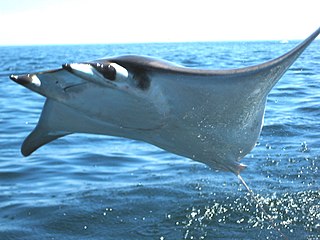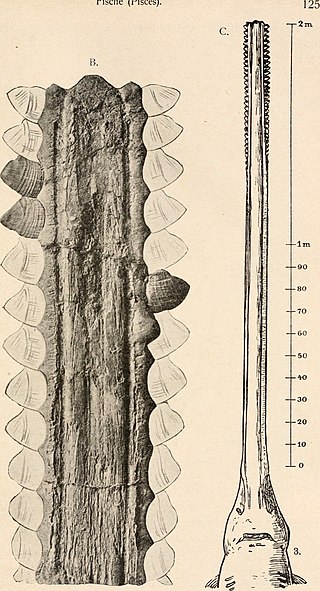Related Research Articles

Mobula is a genus of rays in the family Mobulidae that is found worldwide in tropical and warm, temperate seas. Some authorities consider this to be a subfamily of the Myliobatidae. Their appearance is similar to that of manta rays, which are in the same family, and based on genetic and morphological evidence, the mantas belong in Mobula.

Phosphatherium escuillei is a basal proboscidean that lived from the Late Paleocene to the early stages of the Ypresian age until the early Thanetian some 56 million years ago in North Africa. Research has suggested that Phosphatherium existed during the Eocene period.

Symmoriiformes is an extinct order of stem-group holocephalians. Originally named Symmoriida by Zangerl (1981), it has subsequently been known by several other names. Lund (1986) synonymized the group with Cladodontida, while Maisey (2008) corrected the name to Symmoriiformes in order to prevent it from being mistaken for a family. The symmoriiform fossils record begins during the late Devonian. Most of them died out at the start of the Permian, but Dwykaselachus is known from the Artinskian-Kungurian of South Africa. Teeth described from the Valanginian of France and Austria indicate that members of the family Falcatidae might have survived until the Early Cretaceous; however, these teeth were also argued to be more likely neoselachian teeth.

Falcatidae is a family of Paleozoic holocephalians. Members of this family include Falcatus, a small fish from the Bear Gulch Limestone of Montana. The family first appeared around the start of the Carboniferous, and there is some evidence that they survived well into the early Cretaceous, though its putative Cretaceous members were also argued to be more likely neoselachians.
Gladioserratus is an extinct genus of cow shark. It contains three species:
Eosqualiolus is an extinct genus of sharks in the family Dalatiidae. It was described by Sylvain Adnet in 2006, and the type species is E. aturensis, which existed during the middle Eocene of what is now France. A new species, E. skrovinai, which existed in what is now Slovakia during the Miocene period, was described by Charlie J. Underwood and Jan Schlogl in 2012, and named in honour of Michal Škrovina. E. skrovinai was described from 14 fossil teeth found in the Laksarska Nova Ves Formation; 9 upper and 5 lower, some of which were partial and some were complete.
This list of fossil fish species is a list of taxa of fish that have been described during the year 2012. The list only includes taxa at the level of genus or species.
Togocetus is a genus of extinct cetacean from the Lutetian of Togo, known from a fossilized skeleton discovered a few kilometers north-east of Lomé.

Synechodontiformes is an extinct order of prehistoric sharks, known from the Permian to the Paleogene. They are considered to be members of Neoselachii, the group that contains modern sharks and rays. Their placement in the group is uncertain, some authors have considered them to be galeomorph crown-group sharks, while others have considered them to represent a stem-group to modern sharks. They have sometimes been considered a paraphyletic grouping, but Klug (2010) recovered the group as monophyletic. Members of the clade are united by two synapomorphies, "pseudopolyaulacorhize tooth root pattern present; labial root depression in basal view present". The oldest possible member of the clade are teeth from the early Permian (Cisuralian) of the Ural Mountains.
Rolfodon bracheri is an extinct species from the family Chlamydoselachidae. It lived during the Miocene.
Rolfodon goliath is an extinct species of large frilled shark that lived during the Late Campanian stage of the Late Cretaceous in Angola's southern Benguela Basin. It was described by Miguel Telles Antunes and Henri Cappetta in 2002 during the beginning stages of the PaleoAngola project. Originally it was described as a species belonging to the genus Chlamydoselachus; Cappetta, Morrison & Adnet (2019) transferred it to the chlamydoselachid genus Rolfodon.
Adnetoscyllium is an extinct genus of bamboo shark from the Cretaceous period. It is currently monotypic, containing only the species A. angloparisensis. The genus is named for prominent paleoichthyologist, Dr. Sylvain Adnet. The specific epithet refers to the range which is thus far restricted to the Anglo-Paris Basin of France and the United Kingdom.
Aturobatis is an extinct genus of Myliobatiform ray from the Eocene epoch. It contains a single described species, A. aquensis; however, the range of variation in this species is not well understood and it is unclear whether all specimens attributed to the genus are the same species. It is also unknown to which family this genus belongs. The type locality is the Lutetian of southern France. This genus is also known from the Ypresian of the United States, the Lutetian Lisbon Formation of Alabama, and the Priabonian Samlat Formation of Dakhla, Morocco.
Argoubia is an extinct genus of devil ray from the Paleogene period. It is named for the town of El Argoub, Morocco. The type species, A. barbei, is from the Priabonian-aged Samlat formation of Morocco. The specific epithet honors Mr. Gérard Barb who helped collect the first specimens of this species. A. arnoldmülleri is a second species from the middle Oligocene Böhlen Formation of the Zwenkau lignite mines of Germany. It is named for Dr. Arnold Müller, curator of Palaeontological and Geological collections at Leipzig University.
Arechia is an extinct genus of stingaree from the Eocene epoch. It is the oldest known stingaree genus, though molecular data suggests they diverged from Butterfly rays about 75 million years ago or from Deepwater stingrays around the time of the K-Pg transition. The type species, A. arambourgi, is known from isolated teeth found in the Ypresian deposits of Ouled Abdoun, Morocco. It is named for Camille Arambourg, who originally ascribed these teeth to Raja praealba in 1952. Henri Cappetta revised the species in 1983, erecting this genus for those Arambourg called males in this genus and placed the ones he called females in Merabatis. The second species, A. crassicaudata is from the Ypresian-age Bolca Lagerstätte of Italy and is known from several articulated individuals. This species was described in 1818 and was placed in various genera until finally being attributed to this one in 2020. The inferred environment of the Monte Postale site where this species is found matches with the typical warm, shallow environment of extant representatives of this family.
Archaeogaleus is an extinct genus of requiem shark from the Cretaceous period. It is known only from the species A. lengadocensis. It was described from the Valanginian stage of France. The specific epithet refers to Lengadòc, the region where Occitan was historically spoken. It is the oldest known requiem shark and has a presumed dentition similar to the modern form Scoliodon.
Antrigoulia is an extinct genus of palaeospinacid shark from the Cretaceous period. It is named after a farm in the vicinity of the type locality called Mas d’Antrigoule. It is known from a single species consisting of isolated teeth from the Valanginian of France, A. circumplicata. The name is derived from the concentric folds on the labial side of its teeth.

Ctenacanthiformes is an extinct order of elasmobranch fish. They possessed ornamented fin spines at the front of their dorsal fins and cladodont-type dentition, that is typically of a grasping morphology, though some taxa developed cutting and gouging tooth morphologies. Some ctenacanths are thought to have reached sizes comparable to the great white shark, with body lengths of up to 7 metres (23 ft) and weights of 1,500–2,500 kilograms (3,300–5,500 lb). Ctenacanths are typically thought to have existed from the Devonian to the Late Permian, becoming extinct in the Permian-Triassic extinction event. Members of the family Ctenacanthidae may have survived into the Cretaceous based on teeth found in deep water deposits of Valanginian age in France and Austria, however, other authors contend that the similarity of these teeth to Paleozoic ctenacanths is only superficial, and they likely belong to neoselachians instead. The monophyly of the group has been questioned, with some studies recovering the group as a whole as paraphyletic or polyphyletic.

Propristis is an extinct genus of sawfish that lived from the Eocene to the Miocene. It contains two valid species, P. schweinfurthi and P. mayumbensis. It has been found in Egypt, Cabinda, Morocco, Qatar, Spain, the United Kingdom, and the United States. Isolated rostral denticles are the most common remains, but rostra have also been found.
Dagbatitherium is an extinct genus of proboscideans. So far a single molar from the phosphate basins of Togo in West Africa has been found. The fossil dates to the Middle Eocene, around 47 million years ago. A striking feature of the tooth are the three pairs of cusps oriented transversely to the longitudinal axis of the tooth. This feature is found in more derived proboscideans, which are grouped in the Elephantiformes. For its age, Dagbatitherium is the earliest member of Elephantiformes to date. Furthermore, it is characterized by a low tooth crown and a humped occlusal pattern. The genus was described in 2021.
References
- ↑ Adnet, Sylvain; Marivaux, Laurent; Cappetta, Henri; Charruault, Anne-lise; El Mabrouk, Essid; Jiquel, Suzanne; Khayati Ammar, Hayet; Marandat, Bernard; Marzougui, Wissem; Merzeraud, Gilles; Temani, Rim (2020). "Diversity and renewal of tropical elasmobranchs around the Middle Eocene Climatic Optimum (MECO) in North Africa: New data from the lagoonal deposits of Djebel el Kébar, Central Tunisia". Palaeontologia Electronica. 23 (2): a38. doi: 10.26879/1085 .
- ↑ Adnet, Sylvain; Cappetta, Henri; Guinot, Guillaume; Notarbartolo Di Sciara, Giuseppe (2012). "Evolutionary history of the devilrays (Chondrichthyes: Myliobatiformes) from fossil and morphological inference". Zoological Journal of the Linnean Society. 166 (1): 132–159. doi: 10.1111/j.1096-3642.2012.00844.x . ISSN 0024-4082.